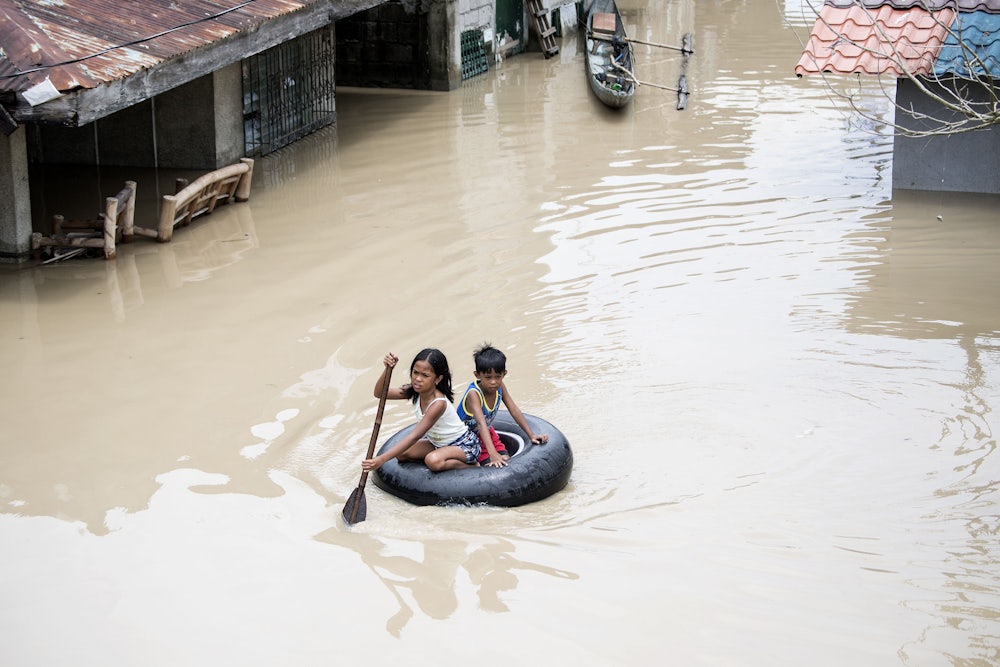Two massive tropical cyclones made landfall on separate ends of the globe on Friday. But they were, as the Associated Press put it, “as different as water and wind.”
The wind storm was Super Typhoon Mangkhut. Deemed the strongest cyclone of 2018, it brought 165 mile-per-hour gusts and 20-foot storm surges to the Philippines, and a bit less of both to Hong Kong. The water storm was Hurricane Florence. The slow-moving storm brought only 90 mile-per-hour winds to North and South Carolina, but also torrential rainfall that set a record for both states.
These differences illustrate what one disaster preparedness expert told me last week. “Every single storm has its own identity, its own footprint,” he said. “No two are ever alike.” But cyclones’ identities are not just shaped by wind speeds and rainfall totals. They’re defined by the communities they target.
Depending on its location, a massive cyclone could be anything from a minor inconvenience to a life-shattering event. The former is more likely in wealthier, more developed places, the latter more in poor and rural areas. This isn’t a hard and fast rule; hurricanes can kill anyone of any class, anywhere near enough to a coast. But it’s been well-documented that hurricanes hit poor, minority communities the hardest. They are more vulnerable to the risks of natural disasters, and struggle most to recover.
Florence and Mangkhut show this phenomenon well. While both were life-threatening storms, the greatest destruction and loss of life was in poor, remote locations. Nearly 100 people are presumed dead across the Philippines, due not only to the strength of the storm but to the area’s weak infrastructure. The rains triggered landslides, including one that partly buried the small mountainside village of Itogon, killing at least 40 people.
Rescuers search for survivors through mud of landslide after Typhoon Mangkhut lashes the Philippines with strong winds and heavy rain, leaving at least 64 people dead. https://t.co/BaPsfucIIi pic.twitter.com/sh3inDZDxe
— ABC News (@ABC) September 17, 2018
These areas likely will struggle to recover. According to The Guardian, “The livelihoods of thousands has been devastated as crops were flooded just a few weeks before the harvest.”
By the time Mangkhut got to Hong Kong, which is far more developed than the affected areas in the Philippines, the storm had weakened slightly. But it was still powerful enough to tear off “parts of buildings and roofs, while storm surges flooded hotels and restaurants with waters waist-deep,” The Guardian reported. More than 100 people were injured in that phase of the storm. Still, no deaths were reported, an outcome attributed to Hong Kong’s resilient infrastructure. And unlike in the Philippines, a swift recovery is expected.
Just one day after a historic typhoon, Hong Kong was back in the swing of things. The impressive recovery time is, as one official from the @AmChamHK told me, a testament to the city’s infrastructure design and diligent coordination with @HKObservatory. pic.twitter.com/7VPfuj7gIJ
— Alexander Kaufman (@AlexCKaufman) September 17, 2018
Florence hit neither a city like Hong Kong nor a ramshackle town like Itogon. As CityLab reported last week, the hurricane’s path included “fragile coastal resorts and historic cities like Charleston and Wilmington”—urban, well-off areas. But Florence was also headed straight for “more isolated inland regions, where a lack of resources, poor communications infrastructure, and challenging geography can hamper emergency efforts.” At least 32 people have died as a result of the storm.
In some cases, rural Americans are actually better equipped to deal with storm impacts. “You’re more accustomed to the occasional power outage, because you know no one is coming to help you,” disaster relief expert Randy Creamer told CityLab. “But when you get to the economically depressed areas… a single mom working three jobs, there is not a lot she can be thinking about how to get over this all by herself.”
It will take time to realize the economic effects of Florence on North Carolina’s poorer, more rural communities. But it is already clear they’re shouldering an unequal burden from the storm. On Monday, North Carolina power company Duke Energy said two of its coal ash pits had breached, spilling toxic-metal laden waste from coal burning into the surrounding environment. Several lagoons of hog feces and urine have also spilled over due to torrential rain. As CityLab noted, “Hispanic low-income communities are disproportionately located near such sites of industry and agriculture, and all of these associated wastes.”
Overall, North Carolina is able to recover from a hurricane relatively quickly. It’s relatively well-developed, home to a number of military bases, and is on the U.S. mainland, not far from FEMA headquarters in Washington, D.C. The same can’t be said for Puerto Rico. The U.S. territory, where nearly 45 percent of residents live below the poverty line, already lacked decent sewage, electricity, and road infrastructure when Hurricane Maria hit last year. But it also failed to receive adequate aid, due to isolation and political indifference. Nearly 3,000 people died.
The physical characteristics of hurricanes are expected to change over time. As humans emit more greenhouse gases, further warming the world, climate scientists predict deadly tropical cyclones will become rainier; that they may move more slowly and venture further into the northern hemisphere; and the hurricane season may become longer. The developed world’s emissions will be responsible for these changes. But it’s the developing world that may suffer the most from it.
